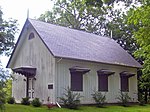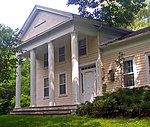Stone Jug

The Stone Jug is a historic house at the corner of NY 9G and Jug Road in Clermont, New York, United States. It dates to the mid-18th century and is largely intact, although it has been expanded somewhat since then. It was built by Konradt Lasher, a Palatine German immigrant to the area who first farmed as a tenant of Robert Livingston. Unusually in an area where brick was the favored material, he chose stone. In the mid-19th century his descendants bought the land and built a farmhouse, now across the street. It, the stone house and several other buildings from the Lasher family farm were listed on the National Register of Historic Places in 1978. Later, in 1992, it became a contributing property to the Hudson River Historic District, a National Historic Landmark.
Excerpt from the Wikipedia article Stone Jug (License: CC BY-SA 3.0, Authors, Images).Stone Jug
State Highway 9G,
Geographical coordinates (GPS) Address Nearby Places Show on map
Geographical coordinates (GPS)
| Latitude | Longitude |
|---|---|
| N 42.103611111111 ° | E -73.896111111111 ° |
Address
State Highway 9G 3829
12526
New York, United States
Open on Google Maps







